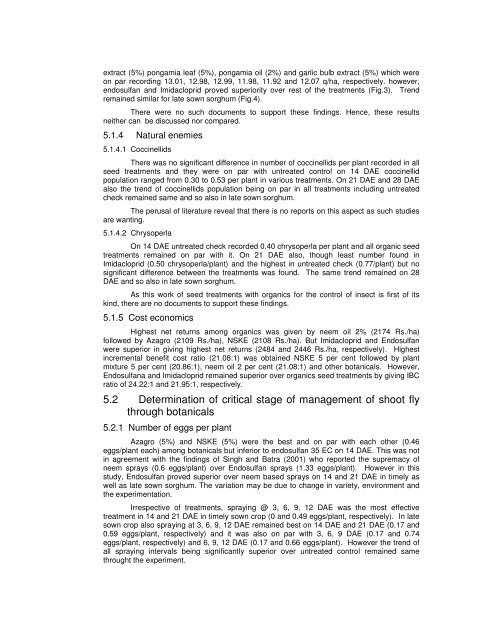NON-CHEMICAL APPROACHES FOR THE MANAGEMENT OF ...
NON-CHEMICAL APPROACHES FOR THE MANAGEMENT OF ...
NON-CHEMICAL APPROACHES FOR THE MANAGEMENT OF ...
You also want an ePaper? Increase the reach of your titles
YUMPU automatically turns print PDFs into web optimized ePapers that Google loves.
extract (5%) pongamia leaf (5%), pongamia oil (2%) and garlic bulb extract (5%) which were<br />
on par recording 13.01, 12.98, 12.99, 11.98, 11.92 and 12.07 q/ha, respectively. however,<br />
endosulfan and Imidacloprid proved superiority over rest of the treatments (Fig.3). Trend<br />
remained similar for late sown sorghum (Fig.4).<br />
There were no such documents to support these findings. Hence, these results<br />
neither can be discussed nor compared.<br />
5.1.4 Natural enemies<br />
5.1.4.1 Coccinellids<br />
There was no significant difference in number of coccinellids per plant recorded in all<br />
seed treatments and they were on par with untreated control on 14 DAE coccinellid<br />
population ranged from 0.30 to 0.53 per plant in various treatments. On 21 DAE and 28 DAE<br />
also the trend of coccinellids population being on par in all treatments including untreated<br />
check remained same and so also in late sown sorghum.<br />
The perusal of literature reveal that there is no reports on this aspect as such studies<br />
are wanting.<br />
5.1.4.2 Chrysoperla<br />
On 14 DAE untreated check recorded 0.40 chrysoperla per plant and all organic seed<br />
treatments remained on par with it. On 21 DAE also, though least number found in<br />
Imidacloprid (0.50 chrysoperla/plant) and the highest in untreated check (0.77/plant) but no<br />
significant difference between the treatments was found. The same trend remained on 28<br />
DAE and so also in late sown sorghum.<br />
As this work of seed treatments with organics for the control of insect is first of its<br />
kind, there are no documents to support these findings.<br />
5.1.5 Cost economics<br />
Highest net returns among organics was given by neem oil 2% (2174 Rs./ha)<br />
followed by Azagro (2109 Rs./ha), NSKE (2108 Rs./ha). But Imidacloprid and Endosulfan<br />
were superior in giving highest net returns (2484 and 2446 Rs./ha, respectively). Highest<br />
incremental benefit cost ratio (21.08:1) was obtained NSKE 5 per cent followed by plant<br />
mixture 5 per cent (20.86:1), neem oil 2 per cent (21.08:1) and other botanicals. However,<br />
Endosulfana and Imidacloprid remained superior over organics seed treatments by giving IBC<br />
ratio of 24.22:1 and 21.95:1, respectively.<br />
5.2 Determination of critical stage of management of shoot fly<br />
through botanicals<br />
5.2.1 Number of eggs per plant<br />
Azagro (5%) and NSKE (5%) were the best and on par with each other (0.46<br />
eggs/plant each) among botanicals but inferior to endosulfan 35 EC on 14 DAE. This was not<br />
in agreement with the findings of Singh and Batra (2001) who reported the supremacy of<br />
neem sprays (0.6 eggs/plant) over Endosulfan sprays (1.33 eggs/plant). However in this<br />
study, Endosulfan proved superior over neem based sprays on 14 and 21 DAE in timely as<br />
well as late sown sorghum. The variation may be due to change in variety, environment and<br />
the experimentation.<br />
Irrespective of treatments, spraying @ 3, 6, 9, 12 DAE was the most effective<br />
treatment in 14 and 21 DAE in timely sown crop (0 and 0.49 eggs/plant, respectively). In late<br />
sown crop also spraying at 3, 6, 9, 12 DAE remained best on 14 DAE and 21 DAE (0.17 and<br />
0.59 eggs/plant, respectively) and it was also on par with 3, 6, 9 DAE (0.17 and 0.74<br />
eggs/plant, respectively) and 6, 9, 12 DAE (0.17 and 0.66 eggs/plant). However the trend of<br />
all spraying intervals being significantly superior over untreated control remained same<br />
throught the experiment.
















